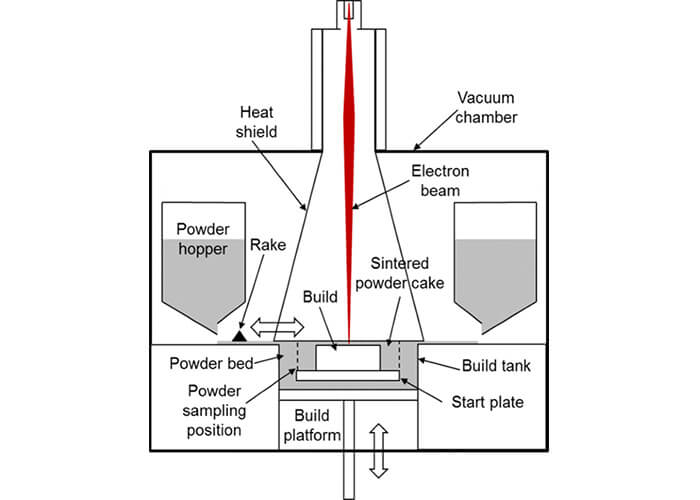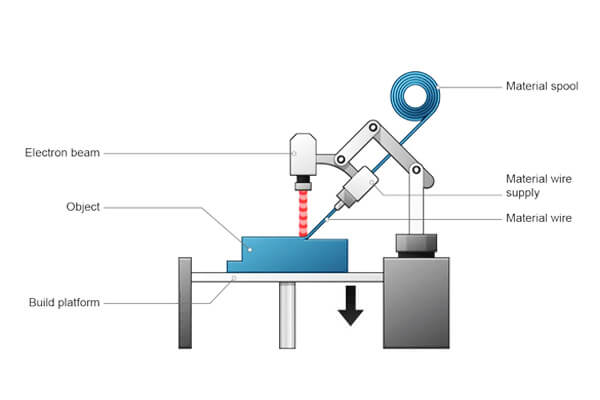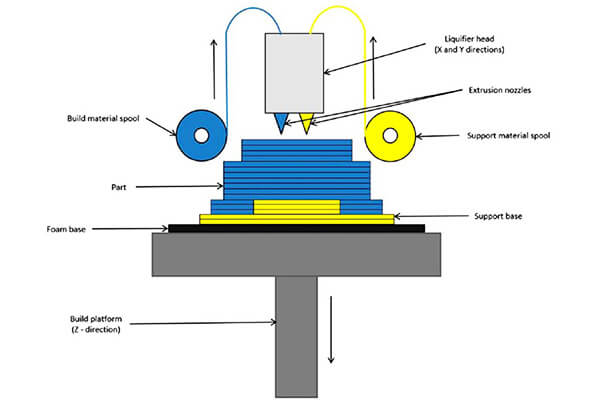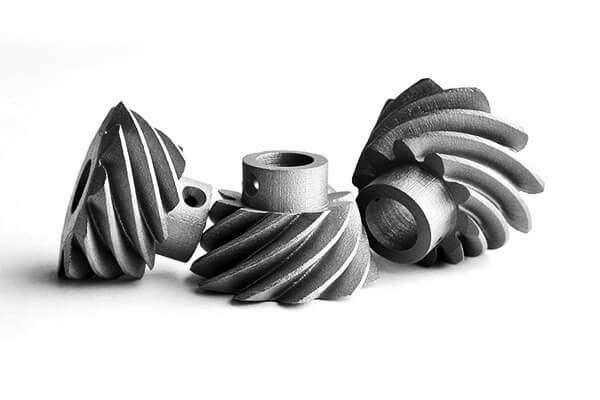1. Įvadas
Metal 3D printing, also known as metal additive manufacturing, is revolutionizing the way products are designed, prototyped, and manufactured.
This technology allows for the creation of complex, high-performance parts directly from digital models, offering unprecedented design freedom and material efficiency.
Here’s why metal 3D printing is gaining traction:
- Tinkinimas: It enables the production of highly customized parts for niche applications.
- Greitas prototipų kūrimas: Speeds up the design iteration process significantly.
- Sumažintos atliekos: Produces parts with minimal material waste compared to traditional manufacturing.
- Sudėtingos geometrijos: Allows for the creation of intricate shapes that are impossible or very costly to produce with conventional methods.
Šiame tinklaraštyje, we’ll delve into the process, nauda, iššūkiai, and applications of metal 3D printing, exploring how this technology is reshaping the manufacturing landscape.
2. What is Metal 3D Printing?
Metal 3D printing is a form of additive manufacturing where layers of material, typically in the form of powder or wire, are fused to create a three-dimensional object.
Unlike traditional subtractive manufacturing, which involves cutting away material from a solid block, additive manufacturing builds up the object layer by layer.
This process offers significant advantages in terms of design flexibility, medžiagų efektyvumas, ir gamybos greitis.

The history of metal 3D printing dates back to the 1980s, with the development of Selective Laser Sintering (SLS) and Direct Metal Laser Sintering (DML).
Bėgant metams, advancements in laser technology, Medžiagos, and software have led to the evolution of various metal 3D printing technologies, each with its own set of capabilities and applications.
3. Metal 3D Printing Technologies
Metal 3D printing, Taip pat žinomas kaip priedų gamyba, utilizes various techniques to produce complex and functional metal parts layer by layer, directly from a digital file.
Each metal 3D printing technology has its unique process and benefits, making it suitable for different applications across industries like aerospace, Automobiliai, sveikatos priežiūra, ir energija.
Žemiau, we’ll explore the most common metal 3D printing technologies, their features, ir idealus pritaikymas.
Tiesioginis metalo lazerio sukepinimas (DML) & Selektyvus lazerio tirpimas (SLM)
Apžvalga:
Both DMLS and SLM are powder bed fusion technologies that use high-powered lasers to melt and fuse metal powder into solid parts.
The difference lies primarily in their approach to the metal powder and material properties.
- DML typically uses metal alloys (kaip nerūdijantis plienas, titanas, arba aliuminis) and works with a variety of metal powders, including alloys like Inconel ir kobalto-chromo.
- SLM uses a similar process but focuses more on pure metals kaip nerūdijantis plienas, titanas, ir aliuminis. The laser completely melts the metal powder, fusing it to form a solid part.

Argumentai:
- High Resolution: Capable of producing parts with fine details and complex geometries.
- Puiki paviršiaus apdaila: Can achieve a good surface finish directly from the printer, though post-processing might still be required for the highest quality.
- Wide Material Range: Works with a variety of metals including stainless steel, titanas, aliuminis, Ir dar daugiau.
Trūkumai:
- Slow for Large Parts: The layer-by-layer process can be time-consuming for larger parts.
- Support Structures: Requires support structures for overhanging features, which must be removed post-printing.
- High Thermal Stresses: The high-temperature gradients can induce thermal stresses in the parts.
Idealios programos: Aviacijos ir kosmoso komponentai, Medicininiai implantai, complex tooling, ir didelio našumo automobilių dalys.
Elektronų pluošto tirpimas (EBM)
Apžvalga:
EBM is a powder bed fusion process that uses an electron beam instead of a laser to melt and fuse metal powders. It is performed in a vacuum environment to ensure optimal conditions for melting.
EBM is typically used for high-performance materials like titanas lydiniai, kobalto-chromo, ir Inconel.
- The process operates at Aukšta temperatūra, offering advantages in Aukštos temperatūros našumas ir Tikslumas for specific alloys.

Argumentai:
- No Need for Support Structures: EBM can produce parts without support due to the preheating of the powder bed, which reduces thermal stresses.
- High-Temperature Capability: Suitable for materials that require high temperatures for melting, like titanium.
Trūkumai:
- Materialiniai apribojimai: Limited to materials that are compatible with a vacuum environment, which excludes some alloys.
- Paviršiaus apdaila: The surface finish might not be as smooth as with SLM/DMLS due to the larger beam spot size.
Idealios programos: Medicininiai implantai (especially titanium), aviacijos ir kosmoso komponentai, and parts where the absence of support structures is beneficial.
Binder Jetting
Apžvalga:
Binder jetting involves spraying a liquid binder onto layers of metal powder, which are then fused to form a solid part.
The powder used in binder jetting is typically metal powder, tokių kaip Nerūdijantis plienas, aliuminis, arba bronza.
After the part is printed, it undergoes sintering, where the binder is removed, and the part is fused to its final density.

Argumentai:
- Fast Printing: Can print parts quickly due to the lower energy requirement for binding.
- Full-Color Printing: Allows for full-color printing, which is unique among metal 3D printing technologies.
- No Thermal Stresses: Since the process doesn’t involve melting, there are fewer thermal stresses.
Trūkumai:
- Lower Part Density: Initial parts have lower density due to the binder; sintering or infiltration is required to increase density.
- Requires Post-Processing: Extensive post-processing is necessary, including sintering, infiltration, and often machining.
Idealios programos: Įrankiai, Pelėsiai, sand casting cores, and applications where speed and color are more important than the final part’s density.
Directed Energy Deposition (DED)
Apžvalga:
DED is a 3D printing process where material is melted and deposited onto a surface by a laser, electron beam, or plasma arc.
DED allows for material to be deposited while also adding or repairing parts.
Unlike other methods, DED uses a continuous feed of material (powder or wire), and the material is fused by the energy source as it’s deposited.

Argumentai:
- Didelės Dalys: Suitable for producing or repairing large parts.
- Repair and Coating: This Can be used to add material to existing parts or for surface cladding.
- Lankstumas: Can work with a wide range of materials and can switch between different materials during printing.
Trūkumai:
- Lower Resolution: Compared to powder bed fusion methods, DED typically has a lower resolution.
- Paviršiaus apdaila: Parts often require extensive post-processing for a smooth finish.
Idealios programos: Aviacijos ir kosmoso komponentai, large structural parts, repair of existing components, and adding features to existing parts.
Metal Fused Deposition Modeling (Metal FDM)
Apžvalga:
Metal FDM is a variation of the traditional Fused Deposition Modeling (FDM) procesas, where metal filaments are heated and extruded layer by layer to create 3D parts.
The filaments used are typically a combination of metal powder and a polymer binder, which is later removed during the post-processing stage.
The parts are then sintered in a furnace to fuse the metal particles into a solid structure.

Argumentai:
- Mažesnė kaina: Often less expensive than other metal 3D printing methods, especially for entry-level systems.
- Paprastas naudojimas: Leverages the simplicity of FDM technology, making it accessible for those familiar with plastic printing.
Trūkumai:
- Requires Sintering: The part must be sintered post-printing to achieve full density, which adds time and cost.
- Lower Precision: Less precise than powder bed fusion methods, requiring more post-processing for tight tolerances.
Idealios programos: Small parts, prototipų kūrimas, educational purposes, and applications where cost and ease of use are more critical than high precision.
4. Materials Used in Metal 3D Printing
Vienas iš pagrindinių privalumų Metalo 3D spausdinimas is the wide range of materials it supports, offering unique properties suited to various applications.
The materials used in metal additive manufacturing are typically metalo milteliai that are selectively melted layer by layer,
with each material having distinct advantages depending on the specific needs of the project.
Nerūdijantis plienas
- Charakteristikos:
Nerūdijantis plienas is one of the most common materials used in metal 3D printing due to its Didelė jėga, atsparumas korozijai, ir universalumas. Stainless steel alloys, ypač 316L ir 17-4 Ph, are widely used across industries.
-
- Stiprybė: Didelis tempimo ir takumo stiprumas.
- Atsparumas korozijai: Excellent protection against rust and staining.
- Aparatas: Easily machinable post-printing, making it suitable for a variety of post-processing methods.
Titano lydiniai (Pvz., Ti-6Al-4v)
- Charakteristikos:
Titano lydiniai, ypač Ti-6Al-4v, yra žinomi dėl savo išskirtinis stiprumo ir svorio santykis, atsparumas korozijai, ir gebėjimas atlaikyti aukštą temperatūrą.
-
- Jėgos ir svorio santykis: Excellent mechanical properties with lower density.
- Aukštos temperatūros našumas: Withstands higher temperatures than most other metals.
- Biologinis suderinamumas: Safe for use in medical implants due to non-toxicity.
Aliuminio lydiniai (Pvz., AlSi10Mg)
- Charakteristikos:
Aliuminis is lightweight and offers excellent Šilumos laidumas ir atsparumas korozijai. Lydiniai kaip AlSi10Mg are commonly used in 3D printing because of their Didelis stiprumo ir svorio santykis ir geras apdirbamumas.
-
- Low Density: Ideal for applications requiring lightweight components.
- Šilumos laidumas: High thermal conductivity makes it suitable for heat dissipation applications.
- Paviršiaus apdaila: Aluminium parts can be easily anodized to improve surface hardness and corrosion resistance.
Cobalt-Chrome Alloys
- Charakteristikos:
Cobalt-chrome alloys are known for their Didelė jėga, atsparumas nusidėvėjimui, ir biologinis suderinamumas, which makes them a popular choice for medical applications.
-
- Atsparumas korozijai: Excellent resistance to both corrosion and wear.
- Didelis stiprumas: Particularly useful for heavy-duty industrial applications.
- Biologinis suderinamumas: Cobalt-chrome is non-reactive in the human body, making it ideal for implants.
Nikelio pagrindu pagaminti lydiniai (Pvz., Inconel 625, Inconel 718)
- Charakteristikos:
Nikelio pagrindo lydiniai, tokių kaip Inconel 625 ir Inconel 718, are highly resistant to oksidacija ir high-temperature corrosion.
These alloys offer superior performance in extreme environments where temperature, spaudimas, and corrosion resistance are critical.
-
- Aukštos temperatūros stiprumas: Can withstand extreme heat without losing strength.
- Atsparumas korozijai: Especially against highly corrosive environments like seawater or acidic media.
- Nuovargio atsparumas: High fatigue strength and resistance to thermal cycling.
Taurieji metalai (Pvz., Auksas, Sidabras, Platina)
- Charakteristikos:
Precious metals, tokių kaip aukso, sidabras, ir platina, are used for applications where high aesthetic value ir atsparumas korozijai būtini.
-
- Aesthetic Quality: Ideal for jewelry and luxury items.
- Laidumas: High electrical conductivity makes them suitable for high-precision electrical components.
- Atsparumas korozijai: Excellent resistance to tarnishing and corrosion.
5. Metal 3D Printing Process
The metal 3D printing process typically involves several key steps:
- Žingsnis 1: Design with CAD Software and File Preparation:
-
- Inžinieriai ir dizaineriai naudoja kompiuterinį projektavimą (CAD) software to create a 3D model of the part.
The file is then prepared for 3D printing, including orientation, support structures, and slicing into layers.
Advanced CAD software, such as Autodesk Fusion 360, enables designers to create complex geometries and optimize the design for 3D printing.
- Inžinieriai ir dizaineriai naudoja kompiuterinį projektavimą (CAD) software to create a 3D model of the part.
- Žingsnis 2: Slicing and Parameter Setting:
-
- The 3D model is sliced into thin layers, and parameters such as layer thickness, laser power, and scan speed are set.
These settings are crucial for achieving the desired quality and properties of the final part.
Slicing software, like Materialise Magics, helps in optimizing these parameters for the best results.
- The 3D model is sliced into thin layers, and parameters such as layer thickness, laser power, and scan speed are set.
- Žingsnis 3: Printing Process:
-
- The 3D printer deposits or fuses the metal layer by layer, following the specified parameters. This step can take hours or even days, depending on the complexity and size of the part.
During the printing process, the printer continuously monitors and adjusts the parameters to ensure consistent quality.
- The 3D printer deposits or fuses the metal layer by layer, following the specified parameters. This step can take hours or even days, depending on the complexity and size of the part.
- Žingsnis 4: Post apdorojimas:
-
- After printing, the part may require post-processing steps such as heat treatment, paviršiaus apdaila, and removal of support structures.
Terminis apdorojimas, pavyzdžiui, can improve the mechanical properties of the part, while surface finishing techniques like sandblasting and polishing can enhance the surface quality.
Quality control is essential at each stage to ensure the part meets the required specifications.
- After printing, the part may require post-processing steps such as heat treatment, paviršiaus apdaila, and removal of support structures.
6. Benefits of Metal 3D Printing
Metal 3D printing offers several advantages over traditional manufacturing methods:
Dizaino laisvė:
- Sudėtingos geometrijos, Vidiniai kanalai, and lattice structures can be created, enabling innovative designs that were previously impossible.
Pavyzdžiui, the ability to create hollow, lightweight structures with internal cooling channels is a game-changer in aerospace and automotive engineering.
Greitas prototipų kūrimas:
- Quick iteration and testing of designs, reducing development time and costs.
With metal 3D printing, prototypes can be produced in a matter of days, allowing for rapid feedback and design improvements.
Medžiagos efektyvumas:
- Minimal waste, as only the material needed for the part is used, unlike subtractive manufacturing, which can result in significant material loss.
This is particularly beneficial for expensive materials like titanium and precious metals.
Lengvas:
- Lattice structures and optimized designs can reduce the weight of parts, which is particularly beneficial in aerospace and automotive applications.
Pavyzdžiui, Boeing has used metal 3D printing to reduce the weight of aircraft components, leading to significant fuel savings.
Tinkinimas:
- Tailored solutions for low-volume or one-off production runs, allowing for personalized and unique products.
Customized medical implants, pavyzdžiui, can be designed to fit a patient’s specific anatomy, improving outcomes and recovery times.
7. Iššūkiai ir apribojimai
While metal 3D printing offers many advantages, it also comes with its own set of challenges:
Didelės pradinės investicijos:
- The cost of metal 3D printers, Medžiagos, and post-processing equipment can be substantial.
Pavyzdžiui, a high-end metal 3D printer can cost upwards of $1 million, and the materials can be several times more expensive than those used in traditional manufacturing.
Limited Build Size:
- Many metal 3D printers have smaller build volumes, limiting the size of parts that can be produced.
Tačiau, new technologies are emerging that allow for larger build sizes, expanding the range of possible applications.
Paviršiaus apdaila:
- Parts may require additional post-processing to achieve the desired surface finish, adding to the overall cost and time.
Techniques like chemical etching and electro-polishing can help improve the surface quality, but they add extra steps to the manufacturing process.
Medžiagos prieinamumas:
- Not all metals and alloys are suitable for 3D printing, and some may be difficult to obtain or expensive.
The availability of specialized materials, such as high-temperature alloys, can be limited, affecting the feasibility of certain projects.
Skill and Training:
- Operators and designers need specialized training to effectively use metal 3D printing technology.
The learning curve can be steep, and the need for skilled personnel can be a barrier to adoption, especially for small and medium-sized enterprises.
8. Applications of Metal 3D Printing
Metal 3D printing is finding applications across a wide range of industries:
Aviacijos ir kosmoso:
- Lengvas, complex components for aircraft and satellites, reducing weight and improving performance.
Pavyzdžiui, Airbus has used metal 3D printing to produce lightweight brackets and fuel nozzles, resulting in significant weight savings and improved fuel efficiency.
Automobiliai:
- Custom and performance parts for motorsports, prototipų kūrimas, and production, enhancing vehicle performance and efficiency.
BMW, pavyzdžiui, uses metal 3D printing to produce custom parts for their high-performance vehicles, such as the i8 Roadster.

Medicinos:
- Implantai, protezavimas, and dental applications offer precise geometries and biocompatibility.
Stryker, a leading medical technology company, uses metal 3D printing to produce customized spinal implants, improving patient outcomes and reducing recovery times.
Energija:
- Šilumokaičiai, turbinos, and power generation components improve efficiency and durability.
Siemens, pavyzdžiui, has used metal 3D printing to produce gas turbine blades, which can withstand higher temperatures and pressures, leading to increased efficiency and reduced emissions.
Tooling and Molds:
- Rapid tooling with conformal cooling channels, reducing cycle times and improving part quality.
Conformal cooling channels, which follow the shape of the mold, can significantly reduce cooling times and improve the quality of the final product.
Vartojimo prekės:
- High-end jewelry, custom watches, and electronics enclosures enable unique and personalized products.
Companies like HP and 3DEO are using metal 3D printing to produce high-quality, customized consumer goods, such as luxury watches and electronic cases.
9. Metal 3D Printing vs. Traditional Manufacturing
When comparing metal 3D printing to traditional manufacturing methods, įveikia keli veiksniai:
Greitis ir efektyvumas:
- 3D printing excels in rapid prototyping and low-volume production, while traditional methods are more efficient for high-volume manufacturing.
Pavyzdžiui, 3D printing can produce a prototype in a few days, whereas traditional methods might take weeks.
Išlaidų palyginimas:
- For low-volume or customized parts, 3D printing can be more cost-effective due to reduced setup and tooling costs.
Tačiau, for high-volume production, traditional methods may still be more economical. The break-even point varies depending on the specific application and the complexity of the part.
Sudėtingumas:
- 3D printing enables the manufacture of intricate geometries and internal features that are impossible with conventional methods, opening up new design possibilities.
This is particularly valuable in industries where weight reduction and performance optimization are critical, pavyzdžiui, aviacija ir automobiliai.
Here’s a comparison table summarizing the key differences between Metal 3D Printing ir Traditional Manufacturing:
| Savybė | Metal 3D Printing | Traditional Manufacturing |
|---|---|---|
| Pristatymo laikas | Faster for prototyping, mažos apimties gamyba. | Longer setup times due to tooling and molds. |
| Gamybos greitis | Slower for high-volume production. Ideal for low-volume, individualizuotos dalys. | Faster for mass production, ypač paprastoms dalims. |
| Dizaino sudėtingumas | Can create complex geometries with ease. | Limited by tooling constraints; complex designs need extra steps. |
| Tinkinimas | Ideal for one-off or customized parts. | Customization is more expensive due to tooling changes. |
| Medžiagos prieinamumas | Limited to common metals (Nerūdijantis plienas, titanas, kt.). | Wide range of metals and alloys available for a variety of applications. |
| Material Performance | Slightly lower material strength and uniformity. | Superior strength and more consistent material properties. |
| Pradinė investicija | High initial cost due to expensive 3D printers and metal powders. | Lower initial investment for basic setups. |
| Per-Unit Cost | High for high-volume production; cost-effective for small runs. | Lower for mass production, especially with simple designs. |
| Stiprybė & Patvarumas | Suitable for many applications; may require post-processing for enhanced strength. | Typically higher strength, especially for high-performance alloys. |
| Paviršiaus apdaila | Requires post-processing for smooth finishes. | Typically better surface finishes for simple designs. |
| Post apdorojimas | Required for enhanced mechanical properties, ir paviršiaus apdaila. | Usually minimal post-processing unless complex or high-precision requirements. |
| Medžiagų atliekos | Minimal material waste due to additive nature. | Higher material waste in some methods (Pvz., apdirbimas). |
| Idealiai tinka | Mažos apimties, individualizuotos dalys, Sudėtingos geometrijos, prototipų kūrimas. | Aukštos apimties, paprastos dalys, consistent material properties. |
| Paraiškos | Aviacijos ir kosmoso, Medicininiai implantai, Automobiliai (Mažos tūrio, Sudėtingos dalys). | Automobiliai, Sunkiosios mašinos, pramoninės dalys (didelės apimties, didelio masto gamyba). |
10. Išvada
Metal 3D printing stands at the forefront of manufacturing innovation, offering unique advantages like design freedom, greitas prototipų kūrimas, and material efficiency.
While it faces challenges such as high costs and material limitations, its transformative potential across industries is undeniable.
Nesvarbu, ar dirbate aviacijos srityje, Automobiliai, arba plataus vartojimo prekės,
exploring how metal 3D printing can fit your specific needs might just be the key to unlocking new possibilities in product development and manufacturing.
DEZE provides 3D printing services. If you have any 3D printing needs, Prašau nedvejodami Susisiekite su mumis.



